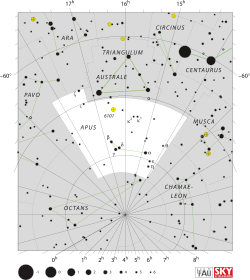Kappa2 Apodis
- For other star systems with this Bayer designation, see Kappa Apodis.
 | |
| Observation data Epoch J2000 Equinox J2000 | |
|---|---|
| Constellation | Apus |
| Right ascension | 15h 40m 21.33360s[1] |
| Declination | –73° 26′ 48.0648″[1] |
| Apparent magnitude (V) | 5.65[2] |
| Characteristics | |
| Spectral type | B7 III-IV + K0 V[3] |
| U−B color index | –0.38[2] |
| B−V color index | –0.04[2] |
| Astrometry | |
| Radial velocity (Rv) | –19.0[4] km/s |
| Proper motion (μ) | RA: –12.36[1] mas/yr Dec.: –20.56[1] mas/yr |
| Parallax (π) | 4.18 ± 0.28[1] mas |
| Distance | 780 ± 50 ly (240 ± 20 pc) |
| Absolute magnitude (MV) | −1.24[5] |
| Details | |
| Luminosity | 351[5] L☉ |
| Other designations | |
| Database references | |
| SIMBAD | data |
Kappa2 Apodis (κ2 Apodis) is the Bayer designation for a double star in the southern circumpolar constellation of Apus. It is located at a distance of roughly 780 light-years (240 parsecs) from Earth, based upon parallax measurements with a 7% margin of error. The pair have a combined apparent visual magnitude of +5.65,[2] which makes the system faintly visible to the naked eye.
The brighter star has a stellar classification of B7 III-IV, with the luminosity class of III-IV suggesting that it may lie in an intermediate stage between a subgiant and a giant star.[7] The faint companion is a K-type main sequence star with a classification of K0 V. It has a visual magnitude of 12.5 and an angular separation of 15 arcseconds from the brighter member.[3]
References
- 1 2 3 4 5 van Leeuwen, F. (November 2007), "Validation of the new Hipparcos reduction", Astronomy and Astrophysics, 474 (2): 653–664, arXiv:0708.1752, Bibcode:2007A&A...474..653V, doi:10.1051/0004-6361:20078357.
- 1 2 3 4 Johnson, H. L.; et al. (1966), "UBVRIJKL photometry of the bright stars", Communications of the Lunar and Planetary Laboratory, 4 (99), Bibcode:1966CoLPL...4...99J.
- 1 2 Eggleton, P. P.; Tokovinin, A. A. (September 2008), "A catalogue of multiplicity among bright stellar systems", Monthly Notices of the Royal Astronomical Society, 389 (2): 869–879, arXiv:0806.2878, Bibcode:2008MNRAS.389..869E, doi:10.1111/j.1365-2966.2008.13596.x.
- ↑ Wilson, Ralph Elmer (1953), General Catalogue of Stellar Radial Velocities, Washington: Carnegie Institution of Washington, Bibcode:1953GCRV..C......0W.
- 1 2 Anderson, E.; Francis, Ch. (2012), "XHIP: An extended hipparcos compilation", Astronomy Letters, 38 (5): 331, arXiv:1108.4971, Bibcode:2012AstL...38..331A, doi:10.1134/S1063773712050015.
- ↑ "HR 5782 -- Star in double system", SIMBAD Astronomical Object Database, Centre de Données astronomiques de Strasbourg, retrieved 2012-07-10.
- ↑ Houk, Nancy (1978), Michigan catalogue of two-dimensional spectral types for the HD stars, 1, Ann Arbor: Dept. of Astronomy, University of Michigan, Bibcode:1975mcts.book.....H.